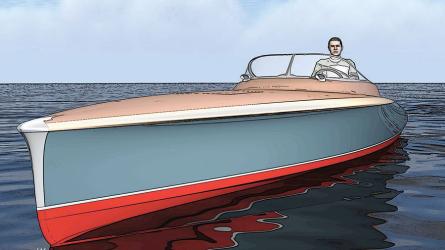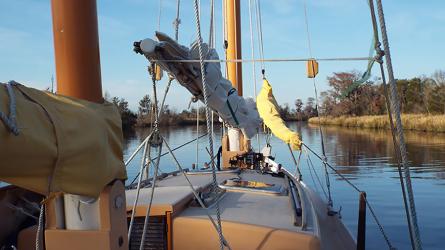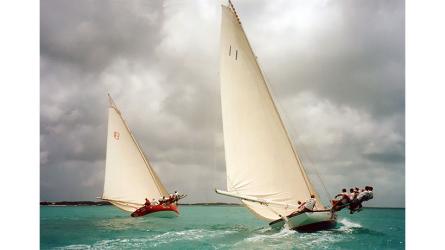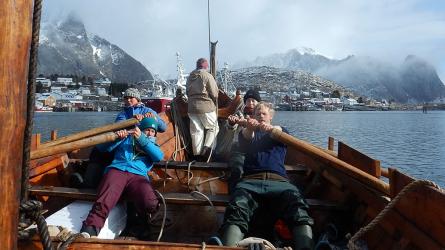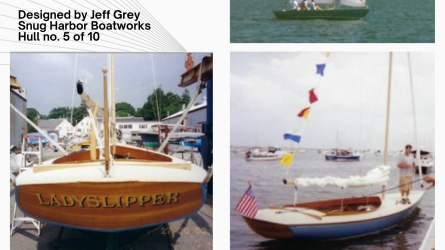Hurricane Preparedness—Part I
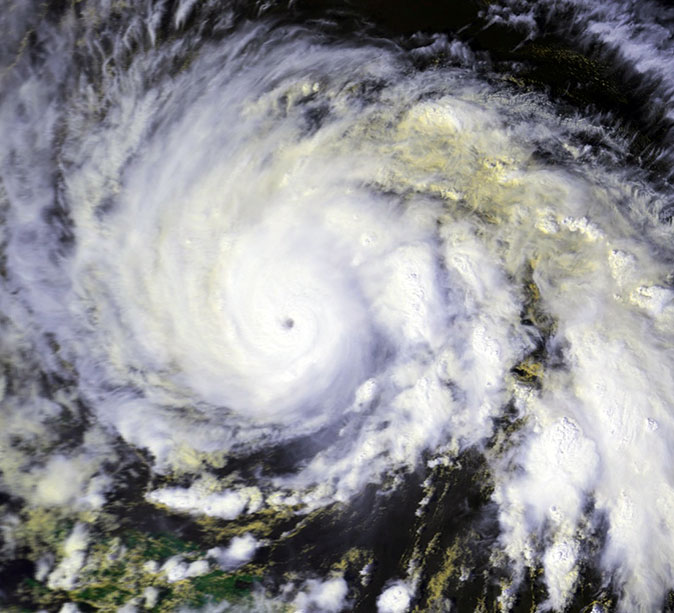
Hurricane Gloria, Sept 25, 1985
I don’t know how many hurricanes I have been through—certainly several dozen if I include my childhood years on the south shore of Long Island. But I have also been through quite a few while living on board one or another of my six cruising sailboat homes over the past 35 years.
Most memorable of these was Hurricane Gloria, which struck Connecticut on September 27, 1985, as a category four storm, the most severe hurricane to strike that far north at that time. I had just launched my new 44′ cold-molded-wood cat schooner TERESA in Rhode Island, and Tere Rodriguez (for whom I named the boat) and I were sailing her to Manhattan for the Mayor’s Cup Schooner Race.
To prepare for Gloria, we anchored TERESA in the Mystic River, up by Mystic Seaport. I chose a shallow place, with a minimum of moored boats near me, taking advantage of TERESA’s 2′ 9″ draft. I placed two anchors out, approximately 180 degrees apart, centering TERESA in a circle with the anchors laid out in the directions from which I anticipated the strongest winds and storm surges. If a hurricane’s eye passes over you (as Gloria’s nearly did), the wind will reverse direction. Normally I lay out three or even four anchors, but Teresa was brand new and didn’t have all her anchors yet (I normally carry at least four).
What I like to carry for my four anchors (on a 45′ boat of light- to moderate-displacement) are a 45 lb plow, two Danforths (a bow anchor of 25 lbs and a stern kedge of 15 lbs), and a Fisherman or Herreshoff anchor of 55 lbs. TERESA’s plow had a 3/8″ x 150′ chain rode, with additional 5/8″ nylon spliced to the chain.
My experience has consistently been that most non-professional mariners are poorly prepared to weather a storm any where any how—but in particular too many cruising boats (especially the Tupperware ones)—are dreadfully under-anchored. Their ground tackle is often pathetic, from number of anchors, to rode size, to bow rollers—and their knowledge and experience often lacks depth (no pun intended). I have watched dozens of boats drag past me even in moderate blows. If they hit me, I often raft them up until the wind pipes down!
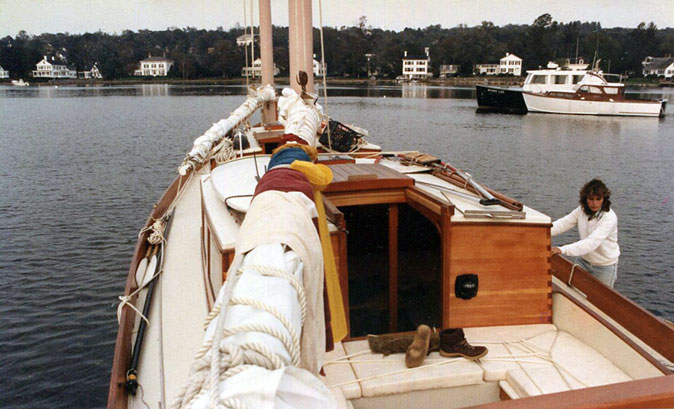
My cat schooner TERESA in the Mystic River, battened down for Hurricane Gloria.
In preparation for Gloria, Tere and I took down all TERESA’s rigging except for one halyard on each mast (necessary to put it all back up). We lowered the booms to the cabin tops, tightly furled (without sail covers), double-lashed the sails to the booms, and tied the booms to handrails, pin rails and cleats as firmly as possible. We stripped her decks of much that could blow away, tied down everything we couldn’t move as securely as possible, and locked her hatches and skylights. I made a big pot of soup in the pressure cooker so we would have food ready, for days if necessary. I kept the coffee pot going, with chocolate and rum handy!
I firmly believe that you should stay with your boat during severe storms. Too many things can go wrong if left to chance. You need to be there to pay out more anchor scope, to renew chafe gear, to fend off vessels dragging into you (very common), and to deal with things as they happen. You can never prepare your boat for every contingency and leave her alone!
Now I don’t mean you should carelessly risk your life. But if you are not at sea, you are not too likely to die tied up in a river or a mangrove swamp—but your boat, without your help, could. In many instances it is even necessary to run your engine against wind and current to take strain off your rodes or mooring lines.
We were lucky with Gloria. We rode it out safely and comfortably, even buffeted by sustained winds of 85 knots with stronger gusts. That plow anchor kept setting deeper and deeper, and as the storm surge raised our water depth from four feet to more than ten, I crawled on my belly out to the bow to pay out more scope.
After the storm, Mystic was without electricity and water for days. Trees were down everywhere, blocking traffic. As the winds abated, and evening approached, Tere and I rowed my dory GANDY DANCER ashore in 20 knot winds to a local Italian restaurant—the only thing open for miles around—for the traditional hurricane party. The owner had propane stoves and lots of candles, and he cooked up a huge spaghetti dinner that probably fed over 100 people. Tere and I sat at the end of the bar, and had a blast!
On September 30 we dug our buried anchors out and departed for New York. On our way down the Mystic River we saw graphic evidence that the rest of the boating world was not paying attention, didn’t care, or maybe they figured their insurance would buy them a new boat. (I have never had insurance, and don’t know of many live-aboard cruisers who have.) People had left their boats unattended, on their moorings, or even tied to docks!
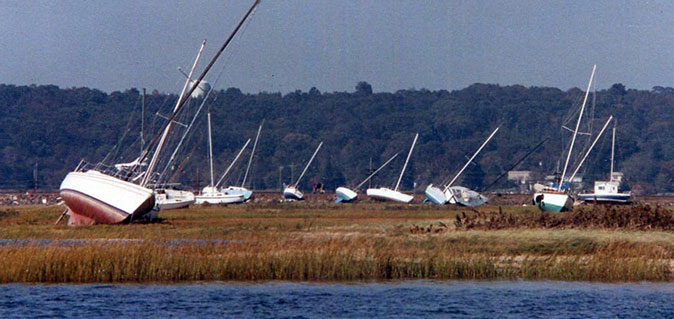
Havoc on the Mystic River.
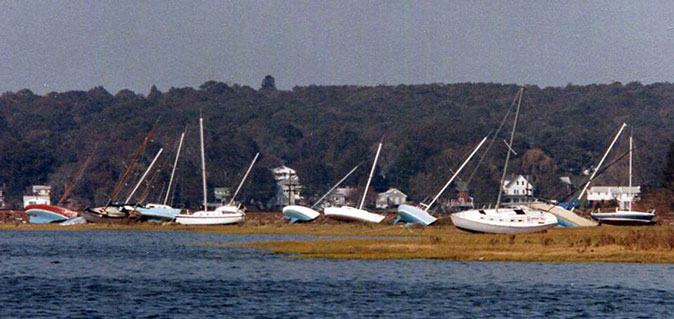
More havoc.
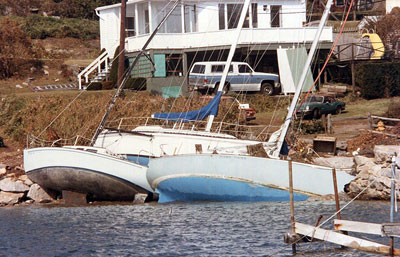
More havoc still.
Some of these boats received minimal damage, having been torn from their moorings and blown ashore floating on the storm surge… and some had holes smashed in them, and other major damage, ensuring that they would never float again. PERHAPS I SHOULDN’T SAY THIS—BUT I DID NOT SEE A SINGLE WOODEN BOAT AMONG THE CARNAGE!
Further reading:
- Typhoon: The Other Enemy, by Captain Calhoun
- Auxiliary Sail Vessel Operations, by Captain Andy Chase
- Oceanography and Seamanship, by William G. Van Dorn (my “nautical bible” for how strong to make things, and how to survive disasters when it comes right down to it!)
St. Lucie Village, May 20, 2014
